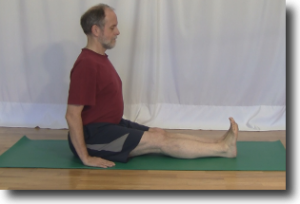
Bob has a computer hunch in his back because he has been working on his old computer for a very long time.
Bob massaged his aching lower back. It has been getting sore a lot lately the more that he works on his computer.
Bob, like a lot of other people, sit at their desk hunched over their computers all day long. He is suffering from the computer hunch.
What is the computer hunch
The computer hunch comes in two parts.
The first part shows up in your lower back when you round your back to get closer to your computer and the second part happens when you bring your arms forward to your keyboard. Your shoulders lift up towards your ears and come forward toward your keyboard. These movements result in a couple of problems.
What is the problem with computer hunch
The computer hunch causes stresses your body in a couple of ways:
- rounding your back causes stress in your lower back muscles which leads to an aching back.
- bringing your shoulders up and forward creates tension in your neck and upper back muscles.
- and finally rounding your back causes you to lower your ribs towards your hips compressing your abdominal organs.
There is an easy way to correct these problems with a yoga pose called Dandasana
What is Dandasana
Dandasana is a seated pose that happens at the very beginning of the Ashtanga Yoga Primary series. Dandasana, which is pronounced dahn-DAH-sah-nah, is the Sanskrit name of the pose. It is known as Staff pose in English.
The pose looks like two staffs, one laying on the ground and the other rising straight up in the air.
Dandasana is the pose that you come to between most of the seated postures in your yoga practice. It is the pose you enter after you finish one seated pose and before you move on to the next one.
Dandasana helps to improve your posture, strengthens your back muscles as well as stretching your back and shoulder muscles.
How to do Dandasana
To start with you sit on the floor with your legs together and straight out in front of you. Now you draw your toes towards you until your feet are vertical.
Next you adjust your torso so that your back is straight with your shoulders directly above your hips.
Now rest your hands on the floor with your fingers pointing forward. Move your hands forward or backward until your wrists are beside your sitz bones and your shoulders are directly above them.
Finally lift your head slightly and bring your gaze to the horizon. You hold this pose for several breaths.
How to eliminate the computer hunch with Dandasana
There are two actions that you take with Dandasana to remove the affects of the computer hunch.
The first action is in the lower back. Bring the top of your hips forward above your sitz bones. You may need to bend your knees a little bit if you have short hamstrings to complete this movement.
Once you get your hips straight up and down you will restore the natural curve to your lower back. Restoring this curve removes the stress from your lower back muscles.
Now that the foundation has been established with your lower back it is time to move on to your shoulders and upper back.
To remove the tension from your upper back, lift your ribs up and away from your hips, take your shoulders down from your ears. Drop your shoulder blades down your back away from your ears and towards each other.
These actions of your ribs and shoulders will remove the tension from your upper back and neck.
When your correct the alignment of your spine with these actions you also remove the compression from your abdominal organs.
Why do all this
These small movements have several positive impacts on your body:
- it improves your posture. These movements, tipping your hips forward, lifting your ribs and dropping your shoulders, straightens your spine and restores the natural curves to your back.
- It reduces stress on your lower back muscles and brings your vertebrae into proper alignment.
- It reduces tension in your neck. Moving your shoulders down from your ears lets your shoulder and neck muscles relax.
- It reduces compression in your abdomen when you lift your ribs up and tip your hips forward.
While all of this is good for you, you can go too far with the adjustments.
Avoid arching your back
Sometimes you may discover that you have too much of a good thing. Lifting your ribs and tipping your hips forward a lot can result in you arching your back. This movement replaces the stretching in your lower back with compression.
You are looking for a middle ground. You are restoring the natural curves in your spine and removing compression from your abdomen not arching your back.
Summary
You can remove the computer hunch in Dandasana with a couple of simple movements of your hips, ribs and shoulders.
Bob can do the same thing at his desk while he is working on his computer. Tip his hips forward to a vertical position, lift his ribs up and drop his shoulders down from his ears.
Next Step
Your yoga teacher can help you with the adjustments in Dandasana to remove the computer hunch and avoiding the compression that comes from arching your back.
Additional Reading
Read How to use the Bent Pin technique to protect your lower back to learn more about Dandasana and your lower back.
The article How to avoid the bow and protect your lower back in Paschimottanasana will help you protect your lower back when you fold forward.
Learning to use your Edge in a yoga pose will help you protect yourself from injury. The article How to find the Edge of your yoga world will help you discover your Edge.




